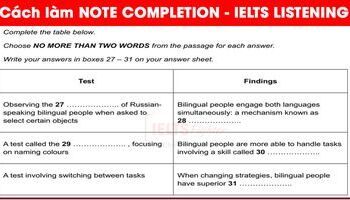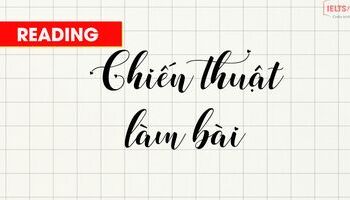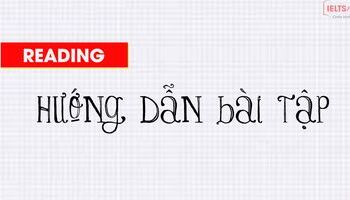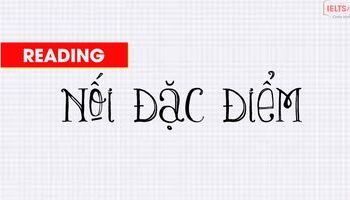Note Completion là dạng bài yêu cầu điền vào chỗ trống để hoàn thành một đoạn tóm tắt cho trước. Đây cũng là một trong những dạng bài xuất hiện thường xuyên nhất trong gần như mọi bài thi IELTS Listening. Dạng Note Completion chủ yếu xuất hiện trong Section 2 và Section 4.
Note Completion trong IELTS Listening
- Đề bài có dạng một đoạn tóm tắt cho một bài giảng/đoạn hội thoại, có một tiêu đề lớn và nhiều đề mục nhỏ bên dưới
- Đề bài yêu cầu bạn điền đáp án đúng vào chỗ trống để hoàn thành đoạn tóm tắt cho trước. Đáp án đúng có thể được thể hiện dưới dạng chữ cái và/hoặc số, vì vậy bạn cần phải đọc kỹ đề bài.
| Question 10- 13 Complete the notes below Write ONE WORD ONLY for each answer
|
Chiến lược làm bài note completion
STEP 1: ĐỌC KỸ CÂU HỎI VÀ XÁC ĐỊNH SỐ TỪ ĐƯỢC PHÉP ĐIỀN
Lưu ý:
- ONE WORD ONLY - Điền một từ duy nhất
Bạn chỉ được phép được điền một từ duy nhất.Ví dụ: Nếu điền là “a pen” câu trả lời của bạn sẽ là sai, phải viết là “pen”
- ONE WORD AND/OR A NUMBER - Điền một từ và/ hoặc một số
Câu trả lời của bạn có thể là một từ, một số, hoặc một từ và một số. Ví dụ: September, hoặc 12th, hoặc 12th September
- NO MORE THAN TWO WORDS AND/OR A NUMBER - Điền không quá hai từ và/hoặc một số
Câu trả lời của bạn có thể là một từ, một số, một từ và một số, hai từ, hai từ và một số. Ví dụ: 15 Bank Road. Nếu như bạn nhìn thấy chỉ dẫn này, thì phần lớn các câu trả lời đều là hai từ hoặc hai từ và một số.
- NO MORE THAN THREE WORDS - Điền không quá ba từ
Câu trả lời của bạn có thể là một từ, hai từ hoặc ba từ. Nếu bạn nhìn thấy chỉ dẫn này, thì phần lớn các câu trả lời đúng đều là điền ba từ
STEP 2: ĐỌC NHỮNG THÔNG TIN ĐÃ CÓ SẴN VÀ GẠCH CHÂN KEYWORD
Trước khi nghe, các bạn hãy lướt nhanh qua phần Note đã hiện sẵn thông tin gì, đặc biệt chú ý đọc đến tiêu đề lớn và tiêu đề nhỏ để nắm được thông tin mà mình sắp nghe thuộc chủ đề gì.
Nếu như xuất hiện tiêu đề nhỏ, ưu tiên đọc các tiêu đề đó trước và tập trung vào các thông liên quan tới chúng khi nghe.
STEP 3: XÁC ĐỊNH LOẠI TỪ CẦN ĐIỀN
4.1. Xác định loại từ cần điển ở mỗi ô trống
| Lightning safety: presentation plan Part 1: planning for lightning •Important to be prepared •Go inside before it 1 _______ Part 2: If inside •Stay away from water, doors, Windows and telephones •Turn off 2 ________ Part 3: if outside •Avoid trees, Open spaces and metal objects •If the lightning comes near you, 3 ________ and cover your ears Part 4: if someone gets hit •Get help from a 4 ________ •Call an ambulance •Don’t worry: 5 _________ of lightning victims survive! |
STEP 4: NGHE THẬT KỸ
Xem thêm cách làm dạng bài trong Listening
Dạng bài Multiple Choice
Dạng bài Form Completion
Những điều cần lưu ý
4.2 Nghe và điền từ còn thiếu vào chỗ trống
- Okay, ________________________ the late 19th century, when a great deal of changes were taking place.
- Now, ________________________ I wanted to give you some background information.
- So, ________________________ some possible reasons for this
|
Luyện tập
4.3
Complete the notes below.
Write ONE WORD ONLY for each answer
| Renovation of Queen’s Theatre History
On the reopening date
|
4.4
Complete the notes below.
Write NO MORE THAN THREE WORDS AND/OR A NUMBER for each answer.
| Project suggestions: pros and cons Localised weather conditions Problem: Not enough time for 1___________ Seasons Problem: Too 2__________ Extreme weather conditions Advantage: Easier to 3___________ into different sections, more interesting |
4.5
Complete the notes below.
Write NO MORE THAN THREE WORDS AND/OR A NUMBER for each answer.
| Group Study booking system To be used for group projects Advance notice required: 48 hours Must reserve using 8_____________________________ Website booking for group study room - need student name and 9 ___________________ Booking confirmation received via 10___________________ |
ANSWER
4.1
1. verb
2. noun
3. verb
4. noun
5. quantity
4.2
- let’s move on to
- first of all
- let’s have a look at
4.3
10. attendance
11. permit
12. Saturday
13. booking
4.4
1. research/our own research/ own research
2. wide reaching / wide-reaching
3. break down
4.5
8. online reservation system
9. (student) number
10. email
SCRIPT
4.3
Welcome everyone. Thanks for turning in to Arts National – the weekly news show focused on the arts community. I’m your host, Adam Easton. Our top story this week is that Auckland will be celebrating the reopening of one of its oldest theaters, widely seen as a push to revive stage entertainment in the city. After nearly 20 year wait, the famed Queens Theatre will once again open to audiences.
The entertainment structure was originally built in 1857. What was the purpose of the facility at that time? Well, it ran stage plays, later movies as well as live performance. But the theater was forced to close in 1972 when attendance started dropping. Audiences were staying home and watching television, and the theater was unable to stay in business.
However, there was renewed interest in the historical structure nearly 25 years later when the Auckland Theatre association – an organization consisting of Auckland’s most renowned theatrical professionals – begin petitioning the city to provide a permit for the theaters renovations. It was granted in 1998, and a local construction crew began work to restore the theater to its original condition. Progress stalled in 2000 the due to a lack of funds, but In 2009 an Anonymous donor provided the necessary money to complete the renovations. Effort recommenced, and the restoration project was finally finished just last month.
According to Michelle McColl, Director of the Auckland Theater Association, their hope is that the reopened Queens Theatre Will provide a space for community, creativity, and youth engagement. A special program Will be held to celebrate the reopening this coming Saturday including several short performances buy theatrical troupes. And then our first scheduled show, a dramatic play entitled “clear path ahead” begins on Monday. Those from the general public who wish to attend the opening performance may purchase tickets from the Auckland Theater Association’s website, or visit the Queen’s Theater box office between the hours of 11 AM and 4 PM any weekday. Seating is limited, with a maximum capacity of 250 people, so a sold-out event is likely. Advance booking is highly recommended.
4.4
A: So, I think we'd better start planning what we're going to do for our group project. Have you guys had any ideas?
B: I was thinking we should do something on extreme weather events, but I think Alex had some different ideas.
C: Yes, Alex, but I don’t think we’d be able to get much data on that, and we don’t really have time to do our own research.
A: What about doing something about the seasons?
B: I think the seasons might be a bit too wide-reaching, you know, when we take into account the wind patterns and pressure systems.
A: Maybe you're right. Well, how about Tom's idea of extreme weather conditions?
B: Yes, that sounds like a good idea. It’s easy to break down into separate parts and it certainly sounds more interesting!
A: maybe we should look into more localised weather conditions and the effects on the immediate environment.
C: That’s a good idea,
4.5
A: Oh, I should also explain how you book the Group Study Room.
B: Oh, yes, so how do I do that?
A: You can only book this room using the online reservation system. The same one you use to reserve books that are currently on loan.
B: I thought it was called the online catalogue system.
A: No, that's for searching for things in the library; the reservation system is what you use to make a room booking.
B: And can I access that from outside the library?
A: Yes, via the library website. You will need to enter the name and student number of each student in the group too, so make sure you have these to hand when you make the booking. But all this is explained on the home page of the website. Once you’ve made your reservation reguest, you’ll receive a confirmation email from the library to sav whether your booking has been successful or not. If not, you can try to arrange another time.
B: Well that sounds fairly easy.
A: Yes, you'll be fine. It's all quite straightforward really.
B: Thanks.
Nguồn tham khảo:
The Official Guide to IELTS for Academic & General Training - Pauline Cullen
Listening for IELTS - Fiona Ash & Jo Tomlinson
HACKER IELTS Listening





